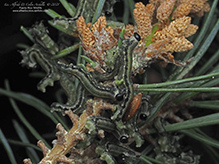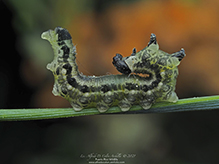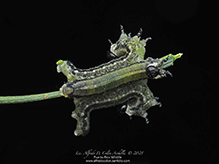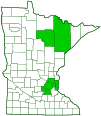European pine sawfly
(Neodiprion sertifer)
Conservation • Description • Habitat • Ecology • Distribution • Taxonomy
Conservation Status |
|
|||||||
| IUCN Red List | not listed |
|||||||
| NatureServe | not listed |
|||||||
| Minnesota | not listed |
|||||||
Description |
||
European pine sawfly is a common, exotic, conifer sawfly. It is native to Europe. It was accidentally introduced into North America in 1925. It now occurs in the United States from Maine to Maryland, west to Minnesota and Missouri, and in western Washington and Oregon. It also occurs in southern Canada from New Brunswick to Ontario. It is the most common sawfly infecting pines in landscapes. The larvae are active from late April to mid-July. Adults are active from late August through September but are seldom seen. They are found in mixed and coniferous forests, parks, and yards. In Minnesota European pine sawfly larvae feed on the needles of Scots pine, jack pine, and red pine. They rarely feed on eastern white pine. They feed on older foliage, avoiding needles of the current year. Young larvae consume only the outer tissue, leaving straw-like, twisted, skeletonized needles. Older larvae consume the entire needle. Defoliated shoots have a bottle brush appearance, with only a tuft of current year needles remaining at the tip. The larvae may also feed on young bark, causing the shoot to be deformed. Branches may die but the tree is seldom killed. European pine sawfly is considered a pest because it attacks Scots pine, which is cultivated as a Christmas tree; red pine, which is often used in pine plantations; and young trees, which are often used in landscaping. Adults are slender, wasp-like, and 5⁄16″ to ⅝″ (8 to 15 mm) in length, and they have a ⅝″ to 1″ (15 to 25 mm) wingspan. They are mostly black with some yellow or orange markings on the thorax and abdomen. The head is black. The antennae on the female are long and have short, tooth-like extensions on one side (pectinate). On the male the extensions are very long, making the antennae appear feather-like on one side only. Mature larvae are 11⁄16″ to 15⁄16″ (18 to 24 mm) in length. They are grayish-green with a pale longitudinal stripe on the back (middorsal), and on each side a dark stripe bordered by light stripes. The head is black. They look like small caterpillars but have six or more pairs of prolegs with no hook-like structures (crochets). |
||
Size |
||
5⁄16″ to ⅝″ (8 to 15 mm) |
||
Similar Species |
||
Habitat |
||
Mixed and coniferous forests, parks, and yards |
||
Ecology |
||
Season |
||
One generation per year: late August through September |
||
Behavior |
||
When threatened, the larva rears back its head and thorax and raises the end of its abdomen, presenting a threatening appearance. Adults are not strong fliers and are usually seen near a host tree. |
||
Life Cycle |
||
The female creates a slit in a needle and inserts a single white egg. It is difficult to spot an infected needle until the first frost, when the tissue over the egg turns yellow or light brown. The needle then reveals an evenly spaced row of six to eight elongated, oval spots. The eggs overwinter and the larvae emerge in mid-April to early May. They pupate in a cocoon, either in a protected place on the bark or in duff on the ground. Adults emerge in the fall. |
||
Larva Food |
||
|
||
Adult Food |
||
|
||
Distribution |
||||
|
Sources |
|||
| 5/17/2023 | ||||
Occurrence |
||||
|
||||
Taxonomy |
|||
Order |
Hymenoptera (ants, bees, wasps, and sawflies) | ||
Suborder |
Symphyta (sawflies, horntails, and wood wasps) | ||
Superfamily |
Tenthredinoidea (typical sawflies) | ||
Family |
Diprionidae (conifer sawflies) | ||
Subfamily |
Diprioninae | ||
Genus |
Neodiprion | ||
Synonyms |
|||
|
|||
Common Names |
|||
European pine sawfly |
|||
Visitor Photos |
|||||
Share your photo of this insect. |
|||||
| This button not working for you? Simply email us at info@MinnesotaSeasons.com. Attach one or more photos and, if you like, a caption. |
|||||
Alfredo Colon |
|||||
 |
 |
||||
 |
|||||
MinnesotaSeasons.com Photos |
|||||
|
|||||

Slideshows |
||
| Neodiprion sertifer (Geoffroy, 1785) Ian Andrews |
||
 |
||
About
Records are few, but spread across VCs 61-64 Larvae feed gregariously on pine, esp. P. silvestris. |
||

Visitor Videos |
|||
Share your video of this insect. |
|||
| This button not working for you? Simply email us at info@MinnesotaSeasons.com. Attach a video, a YouTube link, or a cloud storage link. |
|||
Other Videos |
|||
| European Pine Sawfly Larvae (Neodiprion sertifer) ONnaturegirl |
|||
About
Jul 4, 2013 Pine sawfly larvae moving in unison |
|||
| Neodiprion sertifer-ravageur de Pin Lise MH |
|||
About
Jun 13, 2020 |
|||
| European Pine Sawfly - University of Kentucky Entomology UKEntomology |
|||
About
Apr 26, 2010 European Pine Sawfly. For more information: http://entomology.ca.uky.edu/ This insect is a pest of urban pine trees. Although it looks like a moth or butterfly caterpillar, this is the larval stage of a wasp. |
|||

Created: 5/17/2023
Last Updated:


